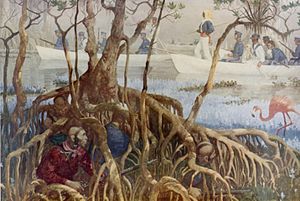Seminole War
| Seminole Wars | |||||||
|---|---|---|---|---|---|---|---|
| Part of American Indian Wars | |||||||
 A U.S. Marine boat expedition searching the Everglades during the Second Seminole War |
|||||||
|
|||||||
| Belligerents | |||||||
|
|
Seminole Choctaw Freedmen |
||||||
| Commanders and leaders | |||||||
|
Martin Van Buren (1837-41) William Henry Harrison (1841) John Tyler (1841-42) Duncan Lamont Clinch Edmund P. Gaines, Winfield Scott (1836) Thomas Jesup (1836-38), Richard Gentry † (1837) David Moniac † (1836), Francis Langhorne Dade † (1835), Zachary Taylor (1838-40), Walker Keith Armistead (1840-41) William J. Worth (1841-42) Franklin Pierce (1856-57) James Buchanan (1857-1858) William S. Harney |
Alexander Arbuthnot † Robert Ambrister † Josiah Francis † Homathlemico † Osceola John Horse Billy Bowlegs |
||||||
United States victory
The Seminole Wars, also known as the Florida Wars, were three conflicts in Florida between the Seminole—the collective name given to the amalgamation of various groups of Native Americans and African Americans who settled in Florida in the early 18th century—and the United States Army. Taken together, the Seminole Wars were the longest and most expensive (both in human and monetary terms) Indian Wars in United States history.
The indigenous peoples of Florida declined significantly in number after the arrival of Europeans in the region. The Native Americans had little resistance to diseases newly introduced from Europe. Spanish suppression of native revolts further reduced the population in northern Florida. By 1707, colonial soldiers from the Province of Carolina and their Yamasee Indian allies had killed or carried off nearly all the remaining native inhabitants, having conducted a series of raids extending the full length of the peninsula. In the first decade of the 18th century, 10,000 – 12,000 Indians were taken as slaves according to the governor of La Florida and by 1710, observers noted that north Florida was virtually depopulated. The few remaining natives fled west to Pensacola and beyond or east to the vicinity of St. Augustine; in 1763, when Spain ceded Florida to Great Britain as part of the Treaty of Paris, the Spanish took the few surviving Florida Indians with them to Cuba and New Spain.
Bands from various Native American tribes from the southeastern United States began moving into the unoccupied lands of Florida. In 1715, the Yamasee moved into Florida as allies of the Spanish, after conflicts with the English colonies. Creek people, at first primarily the Lower Creek but later including Upper Creek, also started moving into Florida from the area of Georgia. The Mikasuki, Hitchiti-speakers, settled around what is now Lake Miccosukee near Tallahassee. (Descendants of this group have maintained a separate tribal identity as today's Miccosukee.)
...
Wikipedia
